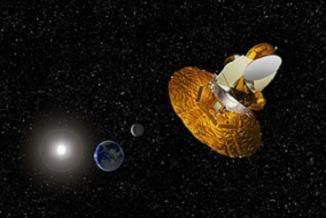Post by glactus on Mar 8, 2008 8:23:18 GMT

The shape of the universe is determined by a struggle between the momentum of expansion and the pull of gravity. The rate of expansion is expressed by the Hubble Constant, Ho, while the strength of gravity depends on the density and pressure of the matter in the universe. If the pressure of the matter is low, as is the case with most forms of matter we know of, then the fate of the universe is governed by the density.
If the density of the universe is less than the "critical density" which is proportional to the square of the Hubble constant, then the universe will expand forever. If the density of the universe is greater than the "critical density", then gravity will eventually win and the universe will collapse back on itself, the so called "Big Crunch".

The Wilkinson Microwave Anisotropy Probe (WMAP; also known as Explorer 80) is a NASA satellite mission to survey the sky and measure the temperature of the radiant heat left over from the Big Bang.
However, the results of the WMAP mission and observations of distant supernova have suggested that the expansion of the universe is actually accelerating which implies the existence of a form of matter with a strong negative pressure, such as the cosmological constant.
This strange form of matter is also sometimes referred to as the "dark energy". If dark energy in fact plays a significant role in the evolution of the universe, then in all likelihood the universe will continue to expand forever.
Geometry of the Universe
The density of the universe also determines its geometry. If the density of the universe exceeds the critical density, then the geometry of space is closed and positively curved like the surface of a sphere.
If the density of the universe is less than the critical density, then the geometry of space is open, negatively curved like the surface of a saddle. If the density of the universe exactly equals the critical density, then the geometry of the universe is flat like a sheet of paper. Thus, there is a direct link between the geometry of the universe and its fate.
The simplest version of the inflationary theory, an extension of the Big Bang theory, predicts that the density of the universe is very close to the critical density, and that the geometry of the universe is flat, like a sheet of paper.
WMAP has confirmed this result with very high accuracy and precision. We now know that the universe is flat with only a 2% margin of error.

Cosmic whispers
credits:
This article has been adapted from material provided by the National Aeronautics and Space administration.
This is part text only. See shape images, full text and all scientists involved at NASA/gov
map.gsfc.nasa.gov/universe/uni_shape.html
Wmap image: maths.org
plus.maths.org/latestnews/sep-dec06/CTC/WMAP.jpg




 then the universe would expand faster or slower depending on appetite and available food source
then the universe would expand faster or slower depending on appetite and available food source 